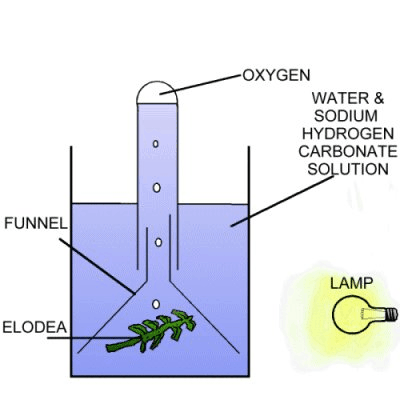Limiting Factors
Elodea (Canadian Pondweed) is often used to investigate the speed of photosynthesis under differnet conditions. As plants produce food by photosynthesis they also give out oxygen. The more food produced the greater the amount of oxygen produced. As Elodea is a pond plant, the oxygen given off can be seen as bubbles. These can either be counted directly or for accuracy the volume of oxygen released can be measured. The gas can be proven to be oxygen as it will relight a glowing splint.
The apparatus below is often used to measure the rate of photosynthesis (the volume of oxygen released in a given time).

The sodium hydrogen carbonate solution provides the elodea with carbon dioxide. The concentration of this can be varied to change the amount of carbon dioxide the plant receives. The lamp provides light. By moving the lamp closer or further you can adjust the amount of light the plant receives. The further away the lamp is the less light it gets. The temperature of the water can also be changed. All these factors will affect the rate of photosynthesis.
Click on the factors below to find out how the factors affect photosynthesis.
These factors are often termed limiting factors. The reason for this is that they can limit the rate of photosynthesis. If any factor is not at the optimum level then photosynthesis will be limited by that factor. For example, the temperature may be just right and the air may contain lots of carbon dioxide, but if there is too little light then the rate of photosynthesis will be low.
